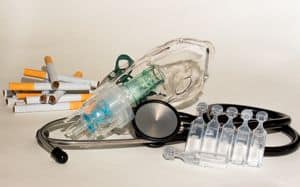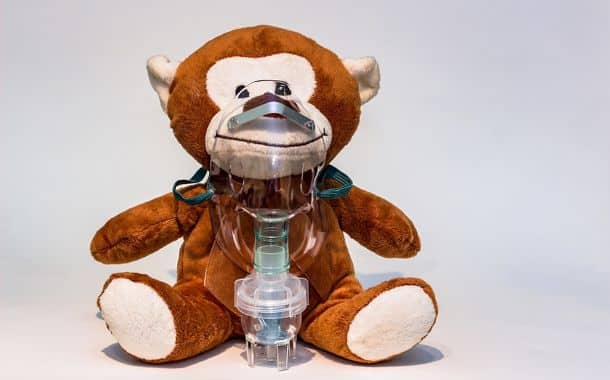How Much Does a Nebulizer Machine Cost?
Last Updated on April 16, 2024
Written by CPA Alec Pow | Content Reviewed by ![]() CFA Alexander Popinker
CFA Alexander Popinker
For the millions of people worldwide relying on nebulizer therapy to effectively administer inhaled respiratory medications and improve breathing, having an efficient and economical home device is a necessity. But with the array of nebulizer types and features now available, making sense of upfront purchase prices and long-term operating costs can be challenging.
This guide provides an in-depth analysis of the many factors affecting both the initial and ongoing costs of acquiring and maintaining home nebulizer equipment. We’ll examine purchase prices, insurance coverage, maintenance needs, hidden fees, and money-saving strategies so you can make an informed, budget-friendly investment in the right system tailored to your specific therapy needs.
While representing a significant medical investment, proper at-home nebulizer therapy provides proven results controlling chronic respiratory diseases like asthma, COPD, cystic fibrosis, and chronic bronchitis cost-effectively.
How Much Does a Nebulizer Machine Cost?
On average, a reliable standard home nebulizer machine for personal use ranges from $50 on the low end for basic pneumatic compressor models up to $250 to $300 for cutting-edge portable ultrasonic or “mesh” type nebulizers. However, prescription insurance coverage and financial assistance programs can reduce patient out-of-pocket expenses drastically, making this vital treatment equipment accessible to more individuals.
Nebulizer equipment breaks down into three primary designs, each with inherent advantages, tradeoffs, and pricing considerations:
Jet Nebulizers – The most common type of affordable home nebulizer uses compressed air from an integrated or standalone electric air pump to convert liquid respiratory medication into a vaporous fine mist for easy inhaled delivery to the lungs. Complete systems with compressor start around $50 to $200.
Ultrasonic Nebulizers – Instead of using compressed air, these high-tech models utilize vibrating piezoelectric crystal plates operating at ultrasonic frequencies to literally shake and nebulize the liquid medicine into inhalable particles. Their more compact size sans air pump makes these systems convenient for portable use, but also more costly around $100 to $250.
Mesh Nebulizers – The most advanced and precise design pressure medication through specialized microporous membranes full of micro-sized holes that nebulize treatments into a perfect aerosol mist shape optimized for deep lung penetration. However, this precision comes at an even higher cost typically ranging from $200 up to $300.
Each type has pros and cons affecting affordability. Jet nebulizers require separate compressors but are very economical. Ultrasonics are compact while mesh types are highly portable.
Amazon Best Sellers offers various nebulizer machines are listed on Amazon with prices ranging from $18.99 to $89.99.
Oxygen Concentrator Supplies provides nebulizer machines and accessories with prices like $29.99, $5.29, $89.99, and more, along with product descriptions and features.
Vitality Medical lists the following products:
- Medneb Compressor Nebulizer: $31.54 – $53.76
- InnoSpire Elegance Compressor Nebulizer System: $41.75 – $49.18
- McKesson Compressor Nebulizer System: $28.25 – $157.22
Factors That Determine Nebulizer Machine Costs
Various performance factors, features and bells and whistles can sway pricing up or down for the main nebulizer equipment types:
- Nebulization mechanism– Compressor, ultrasonic or vibrating mesh
- Brand name and model– Leading manufacturers like Omron and Philips carry higher price tags and perceived value
- Touchscreen controls and digital displays– Advanced interfaces cost more to integrate but allow easier adjustments versus manual knobs and buttons
- Medication reservoir capacity– Larger 7ml+ cups allow longer single treatment sessions but increase base system size and cost along with it
- Portability, size and weight– Compact portable units cost more to miniaturize components while retaining output efficacy
- Power supply– Battery-operated options provide cordless convenience but at much greater expense over standard AC power
- Optional accessories– Add-ons like travel bags or multiple masks ratchet up the total purchase cost
Thinking through must-have features versus nice-to-haves minimizes spending on non-essential capabilities. Focus on core performance needs first.
Costs of Home Nebulizer Machines
To give you a better idea of current market pricing ranges across the main nebulizer equipment categories:
Pneumatic Jet Nebulizers – $50 to $200
- Manual pump compressors – $50 to $100
- Standard electric compressor pump desktop units – $75 to $150
- Portable battery-powered compressors – $150 to $200
Ultrasonic Nebulizers – $100 to $250
- Tabletop electric ultrasonic models – $100 to $150
- Compact portable ultrasonic nebulizers – $200 to $250
Mesh Nebulizers – $200 to $300
Other supplementary costs to account for:
- Sales tax
- Online shipping fees if not purchased locally – $10 to $30
- Optional extended warranty for added years of coverage – $20 to $50
- Distilled water for filling if ultrasonic type.
Prices often vary between retailers for identical models. Shopping around finds the best deals. Consider total initial outlay against expected years of productive service. Upfront cost is only part of the equation – long term value matters too.
Health Insurance Coverage
The high costs of quality home nebulizer systems put them out of reach for many patients facing already burdensome medical expenses. Fortunately, a number of options exist to reduce costs:
Prescription Insurance Plans
- Most insurance prescription plans cover 50-80% of allowed charges for the base nebulizer device and consumable tubing kit.
- Preauthorization may be required along with proof of medical necessity from your doctor.
- Any applicable copay or deductible amounts must still be paid out-of-pocket before coverage activates.
- The plan will also often subsidize prescription respiratory medication placed into the nebulizer under your pharmacy benefits.
You might also like our articles about the cost of ARP wave machine, HIDA scan, or Insulin Pump.
Medicaid and Medicare
- State and federal programs provide assistance with costs based on confirmed medical need.
- Each program has eligibility requirements based on age, income status, and condition diagnosed.
- Preapproval and authorization processes apply before releasing funds.
Supplemental insurance programs like Medigap also help offset any out-of-pocket portions required under Medicare plans.
Confirm your most affordable options to take advantage of available assistance. The right coverage makes this vital treatment equipment accessible.
Tips for Saving Money on a Nebulizer
 Beyond insurance assistance, you can realize major savings on retail nebulizer system pricing through savvy shopping strategies:
Beyond insurance assistance, you can realize major savings on retail nebulizer system pricing through savvy shopping strategies:
Seasonal Sales – Shop end-of-winter sales from February through April when demand lags to find discounted equipment as retailers and suppliers clear inventory. Off-season deals offer great value.
Bundled Pricing – Look for nebulizer kits that package all needed accessories like tubing and masks at discounted combo pricing. Buying piecemeal costs considerably more.
Pre-Tax Purchase Options – Utilize tax-advantaged FSA and HSA accounts to purchase equipment with pre-tax dollars for immediate savings against standard income.
Manufacturer Coupons – Print or download coupons from makers like Omron and Philips for instant discounts on select nebulizer models purchased through approved retailers.
Price Matching – Find the best online advertised deal, then request local medical suppliers match or beat the price. Many will accommodate competitively.
Buy Refurbished/Used – Consider professionally refurbished units at up to 70% off retail pricing. Replace consumables and verify functionality before purchasing.
Looking for deals secures major savings. Never pay full retail if you can avoid it through a little extra effort.
Maintaining a Nebulizer
To keep equipment working at peak performance and avoid issues, ongoing recurring operating costs include:
- Replacing air filters and entire tubing kits every 3-6 months depending on usage – $10 to $50
- Masks, mouthpieces and nebulizer cups as needed based on wear – Disposables cost just $1 to $5 each
- Cleaning and disinfecting solutions to sanitize equipment and prevent dangerous bacteria buildup – $10 to $20 annually
- Testing and calibrating compressor pumps and nebulizer output annually in line with manufacturer guidelines – DIY or professional shop fees $20 to $50
- Compressor pump repairs if electrical or mechanical failures occur – Shop service fees often $50 to $150
Sticking diligently with manufacturer maintenance guidelines keeps equipment hygienic and minimizes unexpected breakdowns or replacements. Proper care directly reduces lifetime costs.
Alternatives to Purchasing
If faced with pressing therapy needs on a very tight budget, options like renting short term or buying professionally refurbished units can provide huge cost savings:
Short Term Rental
- Renting compact nebulizers for travel or to trial a model typically costs $15 to $50 monthly for 1 to 3 months.
- Provides vital access to try equipment without large outright purchases and unknown effectiveness.
Refurbished Purchase
- Professionally reconditioned used nebulizers save 50% to 70% versus new retail.
- Refurbishers replace filters, tubing and verify equipment functionality. Still often includes warranty.
- Allows obtaining advanced models like mesh nebulizers more affordably.
Evaluate if these alternatives offer suitable value for your situation compared to new equipment.
Final Words
In summary, evaluating upfront purchase expenses along with long term operating costs allows consumers to find the ideal nebulizer equipment meeting both therapy performance needs as well as budget constraints through careful comparison shopping.
With vital prescription insurance assistance easing part of the financial burdens, reliable choices fitting both compactness needs and output efficacy requirements are within reach of most patients through diligent research. Focus foremost on product quality, reliability and proven pulmonary drug delivery, then seek available discounts through suppliers and insurance to maximize affordability.
Investing in the right system facilitates adhering to prescribed treatments consistently at home. This offers the best prospects for staying respiratory disease controlled, active and breathing easier over the long term.
Frequently Asked Questions
How long does a typical nebulizer last?
With routine maintenance like cleaning, filter replacements, and avoiding damage, a quality home nebulizer machine will normally last 5-10 years before requiring replacement, depending on frequency of use. More heavy-duty clinical nebulizers can function over 10 years with proper upkeep.
How much does a nebulizer hold?
Most home desktop nebulizer medication reservoirs hold an average of 5-8ml of solution, which typically provides sufficient capacity to deliver complete single nebulized treatment doses without refilling. Larger capacity 10ml+ cups are also available. The required fill amount depends on the specific medication dosage prescribed.
How often can you replace a nebulizer?
To maintain cleanliness and functionality, nebulizer masks, mouthpieces, tubing, and filters should be replaced every 3-6 months with regular use. Tubing kits with all consumables typically cost $10-$50 and take just minutes to swap out. Check components regularly and follow manufacturer guidelines for optimal equipment performance.


Leave a Reply
Want to join the discussion?Feel free to contribute!